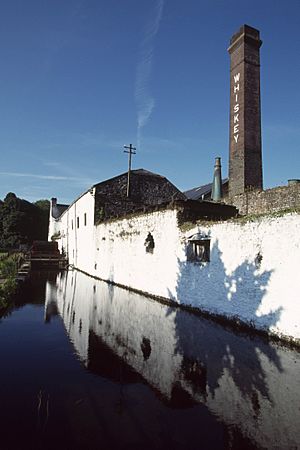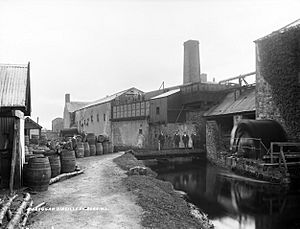Kilbeggan Distillery facts for kids
 |
|
| Location | Kilbeggan |
|---|---|
| Owner | Suntory Global Spirits |
| Founded | 1757 |
| Founder | Matthew MacManus |
| Status | Operating |
| No. of stills | 2 pot stills (wash still: 3,000 L, spirit still: 1,800 L) |
| Mothballed | 1957, reopened 2007 |
| Kilbeggan Distillery Reserve Single Malt | |
| ABV | 40% |
| Kilbeggan Small Batch Rye | |
| ABV | 43% |
The Kilbeggan Distillery is a very old place in Kilbeggan, County Westmeath, Ireland, where Irish whiskey is made. It started way back in 1757, making it one of the oldest distilleries in the world! It sits right by the River Brosna.
For a long time, the distillery was known as Locke's Distillery. It faced tough times in the 1900s and even closed down in 1957. But guess what? The special licence to make whiskey was kept safe! This meant that 50 years later, in 2007, the distillery could open its doors again. Today, it's owned by a company called Suntory Global Spirits.
Some famous people, like former British Prime Minister Sir Winston Churchill, enjoyed whiskey from Kilbeggan.
Contents
A Look Back: The Distillery's History
How It All Began
A man named Matthew MacManus started the distillery in 1757. In its early days, it was a small operation, making about 1,500 gallons of whiskey each year.
By the early 1800s, brothers John and William Codd were running the distillery. In 1841, it was put up for sale. At that time, it had several buildings, including a brew house and a still house with three large pot stills. It also had big storage areas for grain and oats. The distillery used huge amounts of turf (a type of fuel like peat) to power its operations. This even helped many local people find work cutting and bringing the turf to the town.
The Locke Family Takes Over
In 1843, John Locke took charge of the distillery. Under his leadership, the business really grew. John Locke was known for treating his workers very well. He even helped them get homes! Every winter, his staff received a wagon full of coal to keep warm.
There's a great story from 1866 that shows how much the town respected John Locke. A key piece of equipment, the steam boiler, broke down, and the distillery had to stop working. John Locke couldn't afford a new one. So, the people of Kilbeggan came together and bought him a brand-new boiler! They even wrote him a public letter to show their appreciation. John Locke was very touched, calling it "the proudest day of my life." A special plaque in the distillery's restaurant remembers this kind act.
In 1878, a fire broke out at the distillery. It spread quickly and caused a lot of damage. Hundreds of gallons of new whiskey were lost! Luckily, quick-thinking townsfolk helped save thousands of barrels of aging whiskey by rolling them out of the warehouses to safety.
In 1887, a writer named Alfred Barnard visited the distillery. He noted that it was much bigger and was being run by John Locke's sons, John Edward and James Harvey. They told him that production had more than doubled in ten years. Barnard mentioned that the distillery, which he called "Brusna Distillery," was said to be the oldest in Ireland. It covered five acres and employed about 70 people. The distillery made about 157,200 gallons of whiskey each year.
In 1893, the distillery became a company called John Locke & Co., Ltd.
Difficult Times and Closure
In the early 1900s, many Irish whiskey distilleries, including Kilbeggan, faced tough times. This was due to several reasons:
- Prohibition in the United States: A law in America stopped people from selling alcohol, which meant a huge market for Irish whiskey was lost.
- Trade Wars: Difficulties in trading with the British Empire.
- World Wars: Shipping goods became very hard during these global conflicts.
- Competition: New types of whiskey from Scotland became very popular.
Because of these challenges, Kilbeggan had to stop making new whiskey for seven years, from 1924 to 1931. Most of the staff lost their jobs, and the distillery slowly sold off its remaining whiskey. After John Locke's sons passed away, his granddaughters, Mary Evelyn and Florence Emily, took over.
In 1931, after Prohibition ended in the US, whiskey making started again, and things got a little better for a while.
A Difficult Sale and Final Closure
In 1947, the Locke family decided to sell the distillery. It was old, but it had valuable aged whiskey. A potential buyer tried to purchase it, but the deal went wrong, causing more problems for the distillery. This event was widely discussed in Ireland and made it harder to find other buyers.
Then, in 1952, the Irish government increased taxes on spirits, which caused whiskey sales to drop sharply. By 1953, the distillery couldn't even afford to pay the taxes to release whiskey for Christmas sales, and production stopped completely. The company struggled on for a few more years, but in 1958, it finally closed its doors after 201 years of making whiskey.
A New Owner and Changes
In 1962, a German businessman named Karl-Heinz Möller bought the distillery. He sold off the remaining whiskey and even converted parts of the distillery into a pigsty. Many old pottery items from the distillery were sadly destroyed during this time.
Later, in 1969, the distillery was sold again to a company called Powerscreen. In the early 1970s, the old stills and other equipment were removed and sold for scrap metal.
The Distillery Reopens!
In 1982, almost 30 years after it closed, local people in Kilbeggan formed a group called the Kilbeggan Preservation and Development Association. They worked hard to restore the distillery and opened it as a museum for everyone to visit.
Then, in 1987, a new company called Cooley Distillery bought the Kilbeggan distillery's assets. This allowed Cooley to bring back the Kilbeggan and Locke's Whiskey brands. Cooley also took over the museum and started planning to make whiskey there again. It was a big help that the distillery's special licence to make whiskey had been kept active all those years!
In 2007, exactly 250 years after it first opened, whiskey making started again at Kilbeggan! Descendants of the original families who ran the distillery were there to see the pot stills fired up. One of the new pot stills installed was incredibly old – 180 years old! It originally came from the Old Tullamore Distillery and is now the oldest working pot still in the world making whiskey today.
By 2010, with new equipment for mashing and fermenting, Kilbeggan was a fully working distillery once more.
Kilbeggan Distillery Today
Today, the Kilbeggan Distillery is a popular place to visit. It has a restaurant called The Pantry Restaurant and a beautiful 19th-century waterwheel that has been fixed and works again. The distillery can also be powered by an old steam engine, which is still in working order but is only used sometimes. This engine was installed long ago to keep the distillery running even when the river water was low.
Before the distillery reopened, the Kilbeggan and Locke's whiskey brands were made at the Cooley Distillery. The whiskey was then brought to Kilbeggan to age in a 200-year-old granite warehouse. Now, new whiskey made right at Kilbeggan has been aging and is ready to be enjoyed!
Since reopening, the distillery has created a special whiskey called Kilbeggan Small Batch Rye. This is the first whiskey to be completely made and aged at the distillery since its restoration. It's made using malt, barley, and about 30% rye, which was a common way to make whiskey in Ireland in the 1800s.
The distillery's visitor centre was even nominated for an award in Whisky Magazine's Icons of Whisky in 2008, showing how special it is.
Images for kids
See also
- List of historic whiskey distilleries
- Cooley Distillery
- Suntory Global Spirits




